HR Giger on Dune

A. Jodorowsky's DUNE I
H.R. Giger 1975
Acrylic on paper
70 x 100cm

H.R. Giger 1975
A. Jodorowsky's DUNE II
Acrylic on paper
70 x 100cm

H.R. Giger 1976
A. Jodorowsky's DUNE IV
Acrylic on paper
70 x 100cm

H.R. Giger 1976
A. Jodorowsky's DUNE V
Acrylic on paper/wood
70 x 100cm

H.R. Giger 1976
A. Jodorowsky's DUNE VI
Acrylic on paper
70 x 100cm

H.R. Giger 1979
DUNE WORM XII
Acrylic on paper on wood
70 x 100cm
"I first heard about 'Dune' through Bob Venosa, an American painter of fantastic realism who lived in Cadaqués with his family and was a frequent visitor at Salvador Dali's house. It was a project for a three hour 70 mm science fiction film, in which Dali was to play a leading role for a fee of $100,000 an hour (he was later invited to leave the film because of his pro-Franco statements). Bob Venosa telephoned me to say that the director Alejandro Jodorowsky, to whom Dali had shown my catalogue, was interested in my work. So I went to Spain, but unfortunately Jodorowsky had already left.
"Dali, however, showed a polite interest in my work and introduced his wife Gala, describing her as a specialist in monsters and nightmares whose external appearance completely belied her inner world, Gala then expressed the opinion that I would only need to wear a mask in order to completely match the world of my pictures, and this lead her into an hour-long diatribe against the evils of the world, of which she had years of experience. She was really one of the most impressive ladies I have ever met.
"I returned of Switzerland, stupidly leaving my current girlfriend in Cadaqués, where Dali used her as a model and tried to couple her with a young hippie. Dali wanted to celebrate the ceremony himself and supervise the accompanying rituals, in his own special way. I was secretly amused by the whole affair, as I had just read John Fowles' 'The Magnus' and quite understood what the old fox was up to.
"In December 1975 I went to Paris for the private view of an exhibition about the devil, for which I had designed a coloured poster. While I was there I went to Jodorowsky's studio and left my Paris address. Jodorowsky called me over and showed me the preliminary studies for 'Dune'. Four science fiction artists were busy designing spaceships, satellites and whole planets. As a gesture to me, a couple of photocopies of vaguely suitable pictures from my catalogue had been left lying around. Jodorowsky said that he would like me to try some designs - I could create a whole planet, and I would have a completely free hand. Three-dimensional models would be made from my sketches and actors superimposed on them. I could also design costumes and masks, etc. according to my own ideas.
"My planet was ruled by evil, a place where black magic was practiced, aggressions were let loose, and intemperance and perversion were the order of the day. Just the place for me, in fact. Only sex couldn't be shown, and I had to work as if the film was being made for children. Jodorowsky was fed up with having his films censored. A team of thirty specialists would transform my ideas into film. I was thrilled by the idea.
"When we came to talking about money, he said: "You may be a genius, but we can't pay you as a genius". When I asked him what the other contributors were getting, he said "Foss gets 4000 francs a month" - modest salary indeed for a creative designer on a project costing twenty million. He explained to me at length what good publicity it would be for me etc. We parted after we had agreed that he would telephone me about the salary, and he gave me the script so that I could start work right away.
 "On returning to Switzerland I was astonished to receive a telephone call from one of Jodorowsky's assistants saying that i should produce a view of the castle on the planet we had spoken about, 55 x 65 cm, and bring it to Paris, where they would look at it and see if it was suitable for the film.
"On returning to Switzerland I was astonished to receive a telephone call from one of Jodorowsky's assistants saying that i should produce a view of the castle on the planet we had spoken about, 55 x 65 cm, and bring it to Paris, where they would look at it and see if it was suitable for the film.
"Such are the penalties of being a 'Petit Suisse' ('Little Swiss')."
HR Giger on the Harkonnen Castle
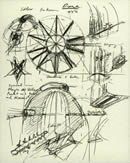 "Harkonnen stands on rising ground, a sort of hill, and consists of jagged bones and excrement which slowly crumble into dust. More bones and excrement are continually being ejected from Harkonnen, which crumble and are swept away by the eternally raging storms. A sort of staircase leads up the hill to the castle, defended by spears built into the bones on either side of the entrance, which have an independent existence and often impale the citizens just for fun.
"Harkonnen stands on rising ground, a sort of hill, and consists of jagged bones and excrement which slowly crumble into dust. More bones and excrement are continually being ejected from Harkonnen, which crumble and are swept away by the eternally raging storms. A sort of staircase leads up the hill to the castle, defended by spears built into the bones on either side of the entrance, which have an independent existence and often impale the citizens just for fun.
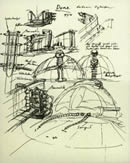 "The castle itself, a symbol of intemperance, exploitation, aggression and brutality with a magical aura which has a negative effect on all the inhabitants, is egg-shaped and mostly burned in the ground. Like an iceberg which shows only a tenth of its volume, Harkonnen hides its evil deep inside. The body of the castle swivels on a circular track like a gun mounting and is surrounded by a bottomless trench some 70 metres wide. The only link with the outside world is a drawbridge which can be lowered like an enormous penis to admit visitors. The main gate is only an entrance, never an exit, for it has barbs like sharks' teeth which prevent anyone from turning back.
"The castle itself, a symbol of intemperance, exploitation, aggression and brutality with a magical aura which has a negative effect on all the inhabitants, is egg-shaped and mostly burned in the ground. Like an iceberg which shows only a tenth of its volume, Harkonnen hides its evil deep inside. The body of the castle swivels on a circular track like a gun mounting and is surrounded by a bottomless trench some 70 metres wide. The only link with the outside world is a drawbridge which can be lowered like an enormous penis to admit visitors. The main gate is only an entrance, never an exit, for it has barbs like sharks' teeth which prevent anyone from turning back.
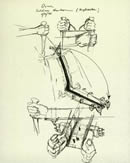 "The two walls of the drawbridge can be brought together hydraulically, crushing visitors who are hostile to the castle. the enemy's remains are scraped off by so-called wall cleaners when the bridge is in the raised position and fall into a conversion paint. Harkonnen is a gigantic Moloch, which functions by converting living beings into energy. Every visitor is materially or spiritually exploited (as I was for this film project). Whoever enters the castle stays there for the rest of his life, which in any case can only last a few seconds. The belly of Harkonnen is a gigantic, senseless gothic, empty space in which corpulent beings swing through the abyss on their suspensors. The thin, plump external skin is supported from inside by a bone-like structure in the form of gigantic vertical plates. The egg in the desert, a symbol of fertility and reclusion - nothing but a fragile, empty sham.
"The two walls of the drawbridge can be brought together hydraulically, crushing visitors who are hostile to the castle. the enemy's remains are scraped off by so-called wall cleaners when the bridge is in the raised position and fall into a conversion paint. Harkonnen is a gigantic Moloch, which functions by converting living beings into energy. Every visitor is materially or spiritually exploited (as I was for this film project). Whoever enters the castle stays there for the rest of his life, which in any case can only last a few seconds. The belly of Harkonnen is a gigantic, senseless gothic, empty space in which corpulent beings swing through the abyss on their suspensors. The thin, plump external skin is supported from inside by a bone-like structure in the form of gigantic vertical plates. The egg in the desert, a symbol of fertility and reclusion - nothing but a fragile, empty sham.
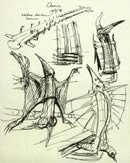 "Opposite the entrance is the ejector system. Here, from time to time, but particularly during attacks, gigantic quantities of charred bones and shit are hurled into the surrounding area, accompanied by thunder and fire.
"Opposite the entrance is the ejector system. Here, from time to time, but particularly during attacks, gigantic quantities of charred bones and shit are hurled into the surrounding area, accompanied by thunder and fire.
"The head of Harkonnen is a gigantic defence installation designed to protect the castle from attack by both land and air. The face section of the head at the front of the body can be lowered mechanically revealing a fortified skull which spits death and destruction. In the top of the skull is a landing area for flying machines. The whole head can be raised or lowered, in order to aim it at the target. The upper arms of Harkonnen contain the conversion plants, while the lower arms contain more defence installations against attack from underground."
HR Giger on the 1979-1980 Dune Attempt
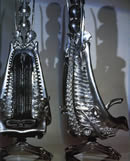 "Dino de Laurentis was now in possession of the rights to Dune. He was interested in Ridley Scott as the director and me for the production designer. After my prior cooperation on the film in 1975 with Jodorowsky, I had started working together with Conny de Fries on the prototype of a bed I had designed, as part of a furniture project I always hoped to realize. The bed was never completed but my involvement with the renewed Dune project provided the opportunity to construct my designs as the Harkonnen furniture pieces and to also have them featured in the film. It was agreed that my contract would allow the copyright of my designs to remain with me and that, later on, I would have the models at my free disposal.
"Dino de Laurentis was now in possession of the rights to Dune. He was interested in Ridley Scott as the director and me for the production designer. After my prior cooperation on the film in 1975 with Jodorowsky, I had started working together with Conny de Fries on the prototype of a bed I had designed, as part of a furniture project I always hoped to realize. The bed was never completed but my involvement with the renewed Dune project provided the opportunity to construct my designs as the Harkonnen furniture pieces and to also have them featured in the film. It was agreed that my contract would allow the copyright of my designs to remain with me and that, later on, I would have the models at my free disposal.
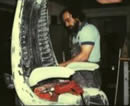 "Under the supervision of Conny de Fries, in a studio near my home, the work began on the technically difficult chair prototype which I had designed for the ruling Harkonnen. Dino Zerbini and Bettina Roost worked with Conny on the modeling and the polyster cast and Bruno Reithaar, a dental technician, did the complex stenciling for the inset foam rubber seat.
"Under the supervision of Conny de Fries, in a studio near my home, the work began on the technically difficult chair prototype which I had designed for the ruling Harkonnen. Dino Zerbini and Bettina Roost worked with Conny on the modeling and the polyster cast and Bruno Reithaar, a dental technician, did the complex stenciling for the inset foam rubber seat.
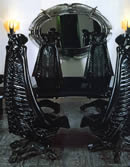 "Still prior to signing he contract I had already completed two new Dune paintings, when I received the news from Ridley Scott that Dino had handed the film over to his daughter. What remained from the project was my own interest in the furniture, which I had financed myself. With the aid of Conny de Fries, the perfect partner fro the realization of my design, over the next few years we completed the project which evolved to include a table, mirror frame and amoire, a complete environment.
"Still prior to signing he contract I had already completed two new Dune paintings, when I received the news from Ridley Scott that Dino had handed the film over to his daughter. What remained from the project was my own interest in the furniture, which I had financed myself. With the aid of Conny de Fries, the perfect partner fro the realization of my design, over the next few years we completed the project which evolved to include a table, mirror frame and amoire, a complete environment.
"Dune was finally realized in 1984 by director David Lynch without my participation."
When Giger heard that David Lynch was to film Dune, he writes to Lynch, sending him photos of his drawings and furniture projects. David Lynch, however, didn't want him involved in the movie, apparently feeling that Giger's style was too well know, since the success of Alien.
For more information on HR Giger visit: HR Giger - The Official Website, or buy one of his many books, which covers Giger's work on Dune: